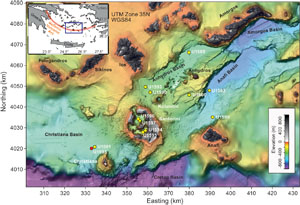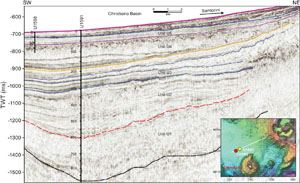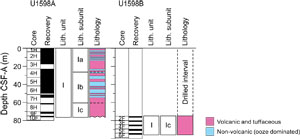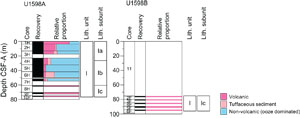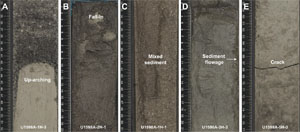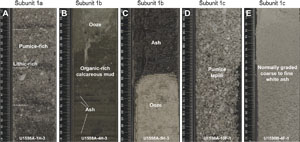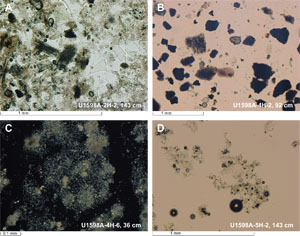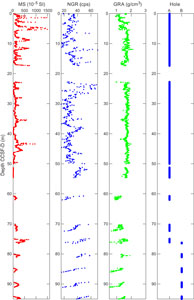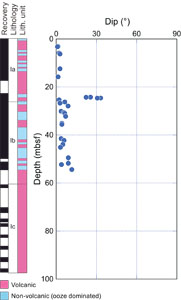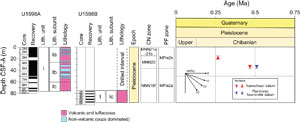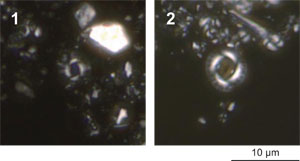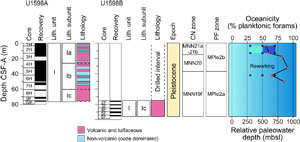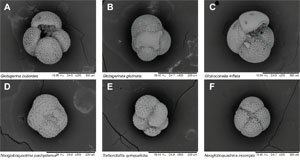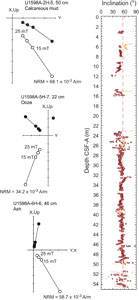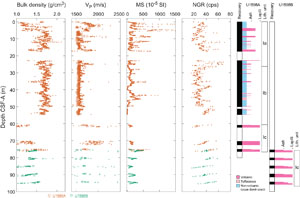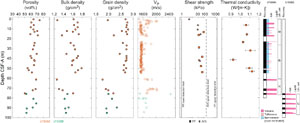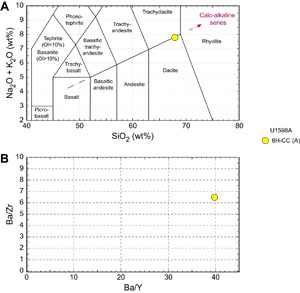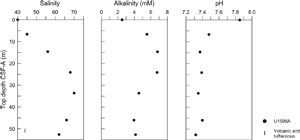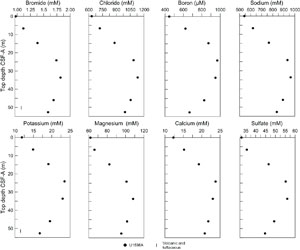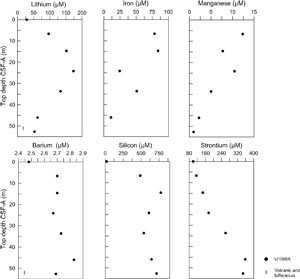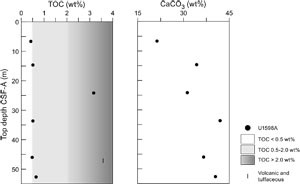Druitt, T.H., Kutterolf, S., Ronge, T.A., and the Expedition 398 Scientists
Proceedings of the International Ocean Discovery Program Volume 398
publications.iodp.org
https://doi.org/10.14379/iodp.proc.398.112.2024
Site U15981
![]() S. Kutterolf,
S. Kutterolf,
![]() T.H. Druitt,
T.H. Druitt,
![]() T.A. Ronge,
T.A. Ronge,
![]() S. Beethe,
S. Beethe,
![]() A. Bernard,
A. Bernard,
![]() C. Berthod,
C. Berthod,
![]() H. Chen,
H. Chen,
![]() S. Chiyonobu,
S. Chiyonobu,
![]() A. Clark,
A. Clark,
![]() S. DeBari,
S. DeBari,
![]() T.I. Fernandez Perez,
T.I. Fernandez Perez,
![]() R. Gertisser,
R. Gertisser,
![]() C. Hübscher,
C. Hübscher,
![]() R.M. Johnston,
R.M. Johnston,
![]() C. Jones,
C. Jones,
![]() K.B. Joshi,
K.B. Joshi,
![]() G. Kletetschka,
G. Kletetschka,
![]() O. Koukousioura,
O. Koukousioura,
![]() X. Li,
X. Li,
![]() M. Manga,
M. Manga,
![]() M. McCanta,
M. McCanta,
![]() I. McIntosh,
I. McIntosh,
![]() A. Morris,
A. Morris,
![]() P. Nomikou,
P. Nomikou,
![]() K. Pank,
K. Pank,
![]() A. Peccia,
A. Peccia,
![]() P.N. Polymenakou,
P.N. Polymenakou,
![]() J. Preine,
J. Preine,
![]() M. Tominaga,
M. Tominaga,
![]() A. Woodhouse, and
A. Woodhouse, and
![]() Y. Yamamoto2
Y. Yamamoto2
1 Kutterolf, S., Druitt, T.H., Ronge, T.A., Beethe, S., Bernard, A., Berthod, C., Chen, H., Chiyonobu, S., Clark, A., DeBari, S., Fernandez Perez, T.I., Gertisser, R., Hübscher, C., Johnston, R.M., Jones, C., Joshi, K.B., Kletetschka, G., Koukousioura, O., Li, X., Manga, M., McCanta, M., McIntosh, I., Morris, A., Nomikou, P., Pank, K., Peccia, A., Polymenakou, P.N., Preine, J., Tominaga, M., Woodhouse, A., and Yamamoto, Y., 2024. Site U1598. In Druitt, T.H., Kutterolf, S., Ronge, T.A., and the Expedition 398 Scientists, Hellenic Arc Volcanic Field. Proceedings of the International Ocean Discovery Program, 398: College Station, TX (International Ocean Discovery Program). https://doi.org/10.14379/iodp.proc.398.112.2024
2 Expedition 398 Scientists’ affiliations.
1. Background and objectives
Site U1598 (proposed Site 14A) is located ~8 km northwest of Christiana Island and ~20 km southwest of Santorini (Figure F1) at 521.5 meters below sea level (mbsl). The drill site targeted the volcano-sedimentary fill of the Christiana Basin in two holes (U1598A and U1598B), with a maximum recovery depth of 95.7 meters below seafloor (mbsf) (all depths below seafloor are given using the core depth below seafloor, Method A [CSF-A], scale, except in Operations where the drilling depth below seafloor [DSF] scale is used) and core recoveries of 69% and 34%, respectively.
The drill site targeted the volcano-sedimentary fill of the Christiana Basin. This basin was believed to have formed by subsidence along an ENE–WSW fault system before the changing tectonic regime activated the current northeast–southwest rift system in which the Christiana-Santorini-Kolumbo (CSK) volcanic field lies (Tsampouraki-Kraounaki and Sakellariou, 2018; Preine et al., 2022a, 2022b). The Christiana Basin is deeper than the Anhydros and Anafi Basins; its volcano-sedimentary fill potentially recorded the earlier volcanic history of the CSK volcanic field (including the products of Christiana and early Santorini), as well as the younger Santorini and possibly the Milos Volcano to the west along the Hellenic volcanic arc. The now-extinct Christiana Volcano produced lavas and tuffs of unknown ages (Aarburg and Frechen, 1999). An ignimbrite found on Christiani Island (one of the two small islands of the Christiana Volcano), Santorini, and the nonvolcanic island of Anaphi, called the Christiani Ignimbrite, was identified (Keller et al., 2010).
Site U1598 was chosen to complement the previously drilled Site U1591. The aim was to retarget a thick pumice layer found at Site U1591 (uppermost ~65 mbsf; Figure F2), for which we had insufficient samples for our scientific aims, to increase our recovery of the interval. The site addresses scientific Objectives 1–4 and 6 of the Expedition 398 Scientific Prospectus (Druitt et al., 2022).
2. Operations
The vessel arrived at Site U1598 on 24 January 2023 at 1945 h. The vessel was under full dynamic positioning (DP) control at 2015 h, ending the transit and marking the start of Site U1598.
2.1. Hole U1598A
The advanced piston corer/extended core barrel (APC/XCB) bottom hole assembly (BHA) with a bit was assembled. Hole U1598A (36°18.2937′N, 25°7.7155′E) was spudded at 2350 h on 24 January 2023 from 527.0 meters below rig floor (mbrf). Core 1H recovered 3.7 m, establishing the seafloor at 521.5 mbsl (Table T1). Coring continued on 25 January through Core 8H from 60.7 mbsf. The switch was made to the half-length APC (HLAPC) system with Cores 9F–10F at 70.2 mbsf. High torque was observed when drilling; the drill string was worked, but to be conservative the decision was made to pull out of the hole. The drill string was tripped up and out of the hole, and the bit cleared the seafloor at 0715 h, ending Hole U1598A.
2.2. Hole U1598B
The vessel was offset 50 m southwest from Hole U1598A. Hole U1598B (36°18.2747′N, 25°7.6929′E) was spudded at 0805 h, using the offset water depth of 521.5 mbrf. A drill-ahead section was made to 75.3 mbsf. At 1015 h, HLAPC coring recommenced with Cores 2H–6F at 98.8 mbsf, the final depth for Hole U1598B. Excessive torque was again observed, and the decision was made to abandon the hole.
The string was pulled out of the hole with the top drive, and the bit cleared the seafloor at 1430 h. The top drive was racked back, and the pipe trip up continued to 127 mbrf. The bit cleared the rotary table at 1645 h.
The rig floor was secured. The thrusters were raised, starting at 1720 h. The vessel was switched to bridge control at 1725 h. All thrusters were up and secure, and the sea passage started at 1730 h, ending Site U1598.
3. Lithostratigraphy
Cores from two consecutively drilled holes at Site U1598 (Holes U1598A and U1598B) recovered a stratigraphy from 0 to 95.68 mbsf (Figure F3). Hole U1598A consists of Cores 1H–10F (0–76.41 mbsf), and Hole U1598B includes Cores 2F–6F (75.3–95.68 mbsf).
The recovered material is sedimentary and unlithified in both holes and characterized by dominantly volcanic lithologies (ash/tuff, lapilli-ash, lapilli, and tuffaceous mud/ooze) and lesser nonvolcanic sediments of calcareous mud and ooze (Figures F3, F4). Smear slides for microscopic analyses were prepared to confirm macroscopic descriptions of distinct lithology changes at the section level, such as the identification of vitric ash particles in tuffaceous lithologies or crystals in ash layers. The succession of tuffaceous muds/oozes and volcanic layers defines three subunits (Ia–Ic). X-ray diffraction (XRD) data were obtained from six interstitial water (IW) squeeze cake sediment residues from Hole U1598A.
Figure F3 summarizes the lithostratigraphy of Site U1598, displaying core recovery and the lithostratigraphic unit and subunits in Holes U1598A and U1598B. Table T2 provides the upper and lower boundaries, thicknesses, lithostratigraphic summaries, and biostratigraphic ages of the lithostratigraphic unit and subunits (see Biostratigraphy). Figure F4 graphically presents the relative proportions of volcanic, tuffaceous, and nonvolcanic lithologies in each hole with the lithostratigraphic unit and subunits. Figure F5 presents grain size distributions of the sediments, in particular the changes in grain size within the volcanic-dominated subunits, to graphically show the distribution of ash, lapilli-ash, and lapilli. Figure F6 displays different types of core disturbance observed at Site U1598.
The following sections describe (1) the effects of core disturbance, (2) the lithostratigraphic unit and subunits, and (3) XRD results from Site U1598.
3.1. Core disturbance
Several types of core disturbance disrupt the lithostratigraphy at Site U1598 (Figure F6):
- Uparching: slight to moderate coring-induced shear between the sediment and core liner results in bedding uniformly dragged downward along the core margins (Figure F6A). In these intervals, original lithofacies and sedimentary structures are usually slightly to severely disturbed but can still be recognized visually.
- Fall-in: usually recognized at the top of cores by coarse clast-supported intervals (Figure F6B). We exclude these intervals, which at this site may extend up to 6 cm in thickness, from lithostratigraphy interpretations.
- Mixed sediment: occurs in water-saturated, granular core sections where grains and clasts flow and mix, producing moderately to severely disturbed, partially overprinted, sedimentary structures and stratigraphy (Figure F6C).
- Sediment flowage: sediments squeeze out of the formation and flow along the core liner. Relics of squeezed sediments are visible between the liner and the sediment (Figure F6D).
- Cracks: produced by slight brecciation in the original lithologies (Figure F6E).
- Artificial size and density segregation: likely to occur during drilling or with postrecovery core handling processes on board (e.g., inclining, shaking, and plunging cores on the catwalk to compact sediments). Jutzeler et al. (2014) also described pseudohorizontal density grading that can occur while the core is lying flat on deck, resulting in vertical structures once the core is turned upright. Such core disturbance is observed most often in volcanic sediments because increased porosity allows sucking in of seawater during hydraulic piston coring. The resulting soupy texture allows material to flow within the core liner. Secondary normal or reverse grading, or density separation of clasts, may occur as a result of this disturbance and obscure primary sedimentary features.
3.2. Description of unit and subunits
The sediments recovered from Holes U1598A and U1598B comprise one volcanic-rich lithostratigraphic unit (Unit I) (Figure F3). Unit I is divided into three subunits (Ia–Ic) (Figures F4, F5; Table T2). The lithology of this unit and subunits is described below.
3.2.1. Unit I
- Intervals: 398-U1598A-1H-1, 0 cm, to 10F-CC, 20 cm (bottom of the hole; 76.41 mbsf); 398-U1598B-2F-1, 0 cm, to 6F-CC, 25 cm (bottom of the hole; 95.68 mbsf)
- Thickness: >95.68 m
- Depth: 0.00–95.68 mbsf
- Age: Holocene to Middle Pleistocene
- Lithology: volcanic and tuffaceous lithologies (ash, lapilli-ash, and lapilli and tuffaceous mud/ooze) and to a minor extent ooze/organic-rich ooze and organic-rich calcareous mud
Unit I extends from 0 to 76.41 mbsf in Hole U1598A and to 95.68 mbsf in Hole U1598B (Table T2). In both holes, coring ended before reaching the bottom of Unit I. Unit I primarily consists of intercalated volcanic and tuffaceous lithologies punctuated by intervals with variable thicknesses of calcareous mud and ooze (Figures F4, F5). Volcanic intervals (ash, lapilli-ash, and lapilli) commonly have sharp bottom contacts. Figures F7 and F8 highlight core section and smear slide images, respectively, of the most common lithologies sampled from Unit I.
Lithologies consisting of >75% volcanic particles (glass shards, pumice, and crystals) comprise ash, lapilli-ash, and lapilli. Description of ash, lapilli-ash, and lapilli in volcanic intervals was based on the relative abundance of ash-sized (<2 mm) and lapilli-sized (2–64 mm) particles, as described in Lithostratigraphy in the Expedition 398 methods chapter (Kutterolf et al., 2024), with ash and lapilli used when the proportion of one size was >75% and lapilli-ash used when both sizes were present but at <75% abundance (Fisher and Schmincke, 1984). Macroscopically, ash layers are typically white to dark gray, well sorted, range in grain size from fine to coarse ash, and variably mixed with mud at the top. Ash layers are typically nongraded or normally graded and are frequently characterized by a sharp base and a more diffuse and often bioturbated upper boundary that grades into tuffaceous mud. Microscopically, ash layers are characterized by colorless to brownish angular glass shards with or without crystals. Some ash layers have distinct crystal/lithic-rich lag deposits at their base (e.g., Sections 398-U1598A-2H-1 and 2H-2). Microscopic observations of smear slides were useful for the identification of specific minerals (e.g., biotite, feldspar, and pyroxene) in ash. The coarser volcanic intervals in Unit I range from monomictic lapilli-ash containing white to gray pumice lapilli with varying proportions of ash matrix to polymictic lithic-vitric lapilli-ash (Figure F7A). Where recovered, bottom contacts of these coarser units are sharp or bioturbated but commonly affected by uparching drilling disturbance (Figure F6A).
Subunits were defined by the relative proportion of volcanic/tuffaceous intervals and nonvolcanic intervals:
- Subunit Ia (Sections 398-U1598A-1H-1, 0 cm, through 4H-2, 76 cm; 0–23.96 mbsf): primarily lapilli-ash with minor ash and lapilli. Other components include tuffaceous mud/sand, calcareous mud, organic-rich calcareous mud, and minor ooze.
- Subunit Ib (Sections 4H-2, 76 cm, through 7H-CC, 7 cm; 24.96–54.72 mbsf): primarily nonvolcanic material consisting of ooze and organic-rich ooze/calcareous mud, punctuated by tuffaceous mud/ooze and ash.
- Subunit Ic (Sections 8H-1, 0 cm, to the bottom of the hole in Section 10F-CC, 20 cm [60.7–76.41 mbsf], and 398-U1598B-2F-1, 0 cm, to the bottom of the hole in Section 6F-CC, 25 cm [75.3–95.68 mbsf]): ash, lapilli, lapilli-ash, and minor lithic lapilli.
3.2.1.1. Subunit Ia
Subunit Ia extends from 0 to ~23.96 mbsf in Hole U1598A (Sections 1H-1, 0 cm, through 4H-2, 76 cm) (Table T2) and is dominated by volcanic and tuffaceous lithologies with up to 0.5 m thick intercalations of fine-grained muds or oozes. Thicknesses of the volcanic intervals vary from 0.05 m to ~3 m, with the thickest packages consisting of lapilli-ashes (Figure F5). The uppermost 29 cm of Hole U1598A consists of well-sorted yellowish brown mud that overlies a 2 m thick package of subrounded gray to grayish brown lapilli-ash (Figure F7A). This first lapilli-ash is separated from a second lapilli-ash by 0.75 m of calcareous mud and organic-rich calcareous mud. The second lapilli-ash sequence begins with a 10 cm thick ash at 3.76 mbsf that transitions downward into 1.5 m of gray polymictic lapilli-ash interspersed with black ash that contains subrounded gray pumice clasts and volcanic lithics. It has a sharp bottom contact with a light greenish gray calcareous ooze at 5.47 mbsf. Below this, organic-rich oozes and calcareous muds are intercalated with gray to black tuffaceous muds (Figure F8A), ash, and lapilli-ash (Figure F5). Tuffaceous mud contains blocky and pumiceous glass fragments, pyroxene, biotite, feldspar, calcite, and foraminifera (Figure F8A). The lowermost lapilli-ash of this subunit is 1.1 m thick and gray and contains pumice and scoria as well as lithics. Subunit Ia ends with a lapilli-bearing ash at 24.96 mbsf.
Similarities in lithology and sedimentary structure can be recognized between this subunit and Subunit Ia at Site U1591 (see Lithostratigraphy in the Site U1591 chapter [Druitt et al., 2024b]).
3.2.1.2. Subunit Ib
Subunit Ib begins with a dark grayish brown organic-rich calcareous mud that extends from 24.96 to 54.72 mbsf in Hole U1598A (Sections 4H-2, 76 cm, through 7H-CC, 7 cm). This subunit consists of a package of light greenish gray to olive-gray ooze intercalated with light brownish gray to very dark gray organic-rich (sapropelic) ooze, punctuated by many thin (<10 cm) but discrete dark gray to black ash layers (Figure F7C, F7D). Ash layers are characterized by transparent to brownish and blocky glass fragments and may contain numerous crystals (Figure F8B, F8D). Some oozes contain ash pods and shell fragments. One 65 cm thick organic-rich (sapropelic) calcareous mud is distinct in that it has multiple intercalated 1–4 cm thick black ash intervals (Figure F7B). Figure F7C shows the sharp bottom contact of a thicker (60 cm) black ash layer underlain by an ooze. The bottom of Subunit Ib is a 7 cm thick dark gray ash (interval 7H-CC, 0–7 cm).
Similarities in lithology and structure can be recognized between this subunit and Subunit Ib at Site U1591 (see Lithostratigraphy in the Site U1591 chapter [Druitt et al., 2024b]).
3.2.1.3. Subunit Ic
Subunit Ic is a coarse volcanic subunit that extends in Hole U1598A from 60.7 mbsf to the bottom of the hole at 76.41 mbsf (Sections 8H-1, 0 cm, through 10F-CC, 20 cm) and in Hole U1598B from 75.3 mbsf to the bottom of the hole at 95.68 mbsf (Sections 2F-1, 0 cm, through 6H-CC, 25 cm). The bottom of Subunit Ic was not recovered in either hole. This subunit consists of multiple normally graded lapilli and lapilli-ash intervals with tens of centimeter-thick lithic-rich intervals at ~75 mbsf in Hole U1598A and ~75 and 80 mbsf in Hole U1598B. The observed normal grading in this subunit could be the result of drilling disturbance and core handling rather than a primary sedimentary feature. The ash and pumice lapilli in this subunit are subrounded to subangular and white or light gray. Rare orthopyroxene was observed at 60–62 mbsf in Hole U1598A, and rare epidote was observed at 80 and 85 mbsf in Hole U1598B. Lithics within this subunit were of volcanic and metamorphic origin.
Similarities in lithology and structure can be recognized between this subunit and Subunit Ic at Site U1591 (see Lithostratigraphy in the Site U1591 chapter [Druitt et al., 2024b]).
3.3. X-ray diffraction
XRD data were collected from six IW squeeze cake sediment residues from Hole U1598A. XRD spectra of representative Subunit Ia and Ib lithologies are shown in Figure F9. These comprise tuffaceous mud (Figure F9A: Section 2H-2; Subunit Ia), calcareous mud (Figure F9B: 4H-1; Subunit Ia), and ooze (Figure F9C: 7H-1; Subunit Ib). The tuffaceous mud shows the characteristic amorphous hump at low °2θ, indicating the presence of volcanic glass. Identified minerals in all three lithologies are calcium carbonate (calcite, aragonite), quartz, and clay minerals of the illite group. In addition, typically Ca-rich plagioclase, dolomite, halite, and pyrite were identified in some of these lithologies.
4. Stratigraphic correlation
Two holes were drilled at Site U1598. Hole U1598A was drilled to 76.41 mbsf using the APC and HLAPC systems (APC: 0–62.19 mbsf; HLAPC: 70.2–76.41 mbsf). Hole U1598B was drilled without recovery to 75.3 mbsf and then cored to 95.68 mbsf using the HLAPC system. Both holes had only a short overlap between 75.3 and 76.41 mbsf, and no reliable correlation could be identified. Therefore, no affine ties were generated and no shifts were applied to the cores. To illustrate this, Figure F10 shows the magnetic susceptibility (MS), natural gamma radiation (NGR), and gamma ray attenuation (GRA) density measurements from Holes U1598A and U1598B together (see Physical properties), along with the respective depth of the cores.
5. Structural geology
Structural geology analyses at Site U1598 included description of cores retrieved from Hole U1598A. A total of 28 bedding structures were measured, mostly from relatively consolidated intervals. The distributions and dip angles of planar structures (measured to an estimated accuracy of ±2°) are shown in Figure F11. Bedding planes were measured mainly on thin sand beds/laminae and mud boundaries and mostly exhibit horizontal to subhorizontal dips ranging 1°–12° (mean = 5°). However, steeper inclinations develop in slumps in the depth interval 24–25 mbsf at the bottom of Lithostratigraphic Subunit Ia, where dips range 22°–33° (mean = 28°) (Figure F11). Deformation related to drilling and core recovery was noted but not recorded.
6. Biostratigraphy
Planktonic foraminifera, benthic foraminifera, and calcareous nannofossils were examined from core catcher samples and additional split core samples from Hole U1598A to develop a shipboard biostratigraphic framework for Site U1598. Additionally, planktonic and benthic foraminifera provided data on paleowater depths, downslope reworking, and possible dissolution.
Site U1598 cored the Christiana Basin sedimentary sequence and recovered a 76.41 m thick Holocene to Middle Pleistocene sequence composed primarily of volcanogenic sediments and calcareous and tuffaceous oozes. Calcareous nannofossils and planktonic foraminifera provided good resolution in the Holocene through Pleistocene sediments. Biostratigraphic datums recognized at Site U1598 are given in Tables T3 and T4, and an age-depth plot is shown in Figure F12.
Hole U1598A recovered Holocene to Middle Pleistocene–aged sediments (0–0.51 Ma) from Samples 1H-CC, 12–19 cm, to 6H-CC, 0–2 cm (3.74–50.07 mbsf), and sediments of indeterminate age from Samples 7H-CC, 7–9 cm, to 10H-CC, 0–5 cm (54.74–76.41 mbsf).
6.1. Calcareous nannofossils
Calcareous nannofossil biostratigraphy in Hole U1598A was established through analysis of core catcher samples. Nannofossils are common to very rare in samples from the Pleistocene sequence (3.71–54.73 mbsf). Preservation is moderate to poor throughout the sequence, and there is significant reworking of older material in most of the Pleistocene samples. Two nannofossil biostratigraphic datums are recognized at Site U1598, representing a continuous Pleistocene sedimentary sequence. Biostratigraphic datums are given in Table T3, and distribution of calcareous nannofossil taxa is shown in Table T5.
The presence of Emiliania huxleyi in Samples 398-U1598A-1H-CC, 10–12 cm, and 2H-CC, 0–3 cm (3.705–13.115 mbsf), indicates a Middle Pleistocene to Holocene age (≤0.265 Ma) within Zones MNN21a and MNN21b (CNPL11: Backman et al., 2012; NN21: Martini, 1971; CN15: Okada and Bukry, 1980) of Rio et al. (1990) and Di Stefano and Sturiale (2010) (Figure F13). The last appearance datum of Pseudoemiliania lacunosa defines the Zone NN19/20 boundary. The last consistent appearance of P. lacunosa in Hole U1598A occurs in Sample 5H-CC, 28–30 cm (42.03 mbsf).
6.2. Foraminifera
Planktonic and benthic foraminifera were examined from core catcher samples and split core samples from Hole U1598A (Figure F12). Absolute ages assigned to biostratigraphic datums follow those listed in Table T4. Planktonic foraminifer datums are given in Table T3; the distribution of important planktonic and benthic foraminifer taxa is given in Tables T6 and T7; and planktonic foraminifer abundances and indications of oceanicity (Hayward et al., 1999), paleowater depths, and downslope reworking are shown in Figures F14 and F15.
Because of the volcanogenic nature of the cored sedimentary sequence, residues (>125 µm) from washed samples were often significantly composed of volcaniclastic particles such as pumice, scoria, and ash that diluted the microfossil component of residues. Foraminifera dominated the biogenic component of residues, however. Additionally, volcanic material, clastic grains, minor pyrite, carbonaceous plant-derived matter, and other fossil material, including shells and fragments (Bivalvia and Gastropoda), Pteropoda, Scaphopoda, Bryozoa, Arthropoda (crab claws), echinoid spines and plate fragments, and radiolarians, as well as ostracods, were also present in variable amounts in most samples.
In the Holocene to Middle Pleistocene section, foraminifera with very good to moderate preservation are present in siliciclastic and volcaniclastic sediments. Foraminifer abundances are also variable and are notably rare in tuffaceous oozes, likely due to sedimentary dilution, whereas coarser volcaniclastic intervals are sometimes barren.
6.2.1. Holocene to Early Pleistocene biostratigraphy
Because of explosive volcanic events and rapid deposition of the upper sedimentary section, the base of the Holocene is not possible to assign accurately. Planktonic foraminifer assemblages from the Holocene to Early Pleistocene section of Site U1598 are mostly very well preserved where specimens are rarely broken or exhibiting partially dissolved shell walls.
Holocene to Pleistocene foraminifer faunas suggest moderate fluctuations in relative paleowater depth and oceanicity with variable planktonic abundances that range 56%–92% where foraminifera are present (Figure F15). The fauna are typical of Pleistocene Mediterranean biostratigraphic zones, primarily composed of Neogloboquadrina incompta, Globigerina bulloides, Globigerinita glutinata, Globigerinoides elongatus, Globigerinoides pyramidalis, Globigerinoides ruber var. white, Globoconella inflata, Hirsutella scitula, Neogloboquadrina pachyderma, Orbulina universa, Turborotalita quinqueloba, and Globigerinella calida (Figure F16).
Foraminiferal faunas are sufficiently common to biostratigraphically divide the Pleistocene into two Mediterranean planktonic foraminiferal biostratigraphic zones (Lirer et al., 2019):
Because of potential downhole contamination, samples located deeper than 50.07 mbsf were not assigned to a biostratigraphic zone. The faunal criteria on which these age assignments are based are given below.
6.2.1.1. Zone MPle2b (0.00–0.53 Ma)
Samples 398-U1598A-1H-CC, 12–19 cm, to 4H-CC, 25–29 cm (3.74–32.42 mbsf), are assigned to Zone MPle2b based on the first occurrence of Truncorotalia truncatulinoides (first common occurrence = 0.53 Ma), which is generally rare in the Aegean Sea, likely due to the shallow water depths (Lirer et al., 2019).
6.2.1.2. Zone MPle2a (0.53–0.94 Ma)
Samples 398-U1598A-5H-CC, 28–30 cm, to 6H-CC, 7–9 cm (42.04–50.07 mbsf), are assigned to Zone MPle2a based on the absence of T. truncatulinoides s.l. (0.53–0.934 Ma) and the sporadic occurrences of sinistrally coiled Neogloboquadrina spp. (0.51–0.91 Ma) throughout this interval.
6.2.2. Planktonic foraminiferal oceanicity
Planktonic foraminifer abundances are relatively variable, ranging 56%–92% where foraminifera are present (Figure F15). Oceanicity values are generally in agreement with benthic foraminiferal paleowater depth indicators in intervals where reworking is low or absent. The oceanicity data for Site U1598 generally indicate fluctuations from extraneritic to oceanic conditions (100 to >1000 mbsl) through the study section, with a slight trend of deepening paleowater downcore (Figure F15).
6.2.3. Benthic foraminifera paleowater depths
Benthic foraminiferal assemblages are highly variable between abundant to very rare with common reworked/transported specimens. The low abundances of benthic foraminiferal faunas in most samples, such as Samples 398-U1598A-3H-CC, 10–12 cm, to 4H-CC, 25-29 cm (17.52–32.42 mbsf), and 6H-CC, 0–2 cm, to 7H-CC, 7–9 cm (50.07–54.74 mbsf), are possibly correlated with rapid emplacement of volcaniclastic sediments and/or inhospitable environmental conditions. Consequently, no paleowater depth estimates were possible for these intervals. The benthic foraminifer distributions indicate uppermost to upper bathyal (300–700 mbsl) paleowater depths (Figure F15) for Samples 1H-CC, 12–19 cm, to 2H-CC, 0–3 cm (3.74–13.13 mbsf), and 5H-CC, 28–30 cm (42.04 mbsf), which contain common and rare benthic foraminifera of the upper bathyal species Cassidulina spp., Cibicidoides crebbsi, Gyroidina spp., and Trifarina angulosa, as well as other shelf to bathyal markers including common Uvigerina peregrina and common uppermost bathyal species such as Bolivina spathulata. Finally, samples in various intervals exhibit broken and mixed reworked foraminifer faunas, which in some cases are highly abundant, such as in Sample 4H-CC, 25–29 cm (32.42 mbsf), most likely representing downslope reworking and sediment transportation (Figure F15).
7. Paleomagnetism
A total of 30 archive-half sections recovered from Hole U1598A were suitable for paleomagnetic analysis using the 2G Enterprise superconducting rock magnetometer (SRM) system. Alternating field (AF) demagnetization of these sections yielded a total of 1592 measurements in the sections and shows magnetizations generally decayed linearly to the origin following removal of a low-coercivity drilling-induced component after demagnetization at 15 mT (Figure F17). The mean inclination of principal component directions that passed the statistical filtering described for Site U1591 (see Paleomagnetism in the Site U1591 chapter [Druitt et al., 2024b]) is +51.6° (k = 72.9; α95 = 0.6; n = 1306). This is slightly shallower than the geocentric axial dipole field inclination of +56° at this site (Figure F17). Eight discrete samples were also AF demagnetized, and all showed normal polarities of magnetization. No reversals are present in the data set, and the sampled interval is therefore assigned to the Brunhes Chron (C1n, <0.773 Ma; Gradstein et al., 2020), which is compatible with available biostratigraphic age constraints (see Biostratigraphy).
8. Physical properties
The typical increases of bulk density, P-wave velocity, and thermal conductivity with increasing depth are not clearly documented at Site U1598. MS is highly variable in volcaniclastic layers and is sometimes very high. Grain density in volcanic lapilli layers is sometimes <2.0 g/cm3.
8.1. Whole-round GRA density, MS, P-wave velocity, and NGR
Figure F18 summarizes data collected on whole-round cores measured on the GRA densitometer, MS loop, and P-wave logger on the Whole-Round Multisensor Logger (WRMSL), as well as NGR. All cited depths are on the CSF-A scale. A few possible systematic sources of error in these data should be considered when interpreting absolute values and trends:
- Redistribution of unconsolidated volcaniclastic materials in core liners during coring and on the core receiving platform can lead to sorting by particle size and density.
- Core liners often contained large amounts of water. As a result, WRMSL measurements of bulk density are systematically lower than discrete measurements at this site.
- Whole-round measurements in sections that match discrete measurement values on split cores are most reliable.
The volcanic lapilli of Lithostratigraphic Subunit Ic have distinctly lower density than the nonvolcanic, ooze-dominated lithologies of Subunits Ia and Ib. MS is highly variable within the volcaniclastic deposits at this site and can be very high (>2500 × 10−5 SI). High values of MS correspond to volcaniclastic layers. Two high P-wave velocity layers, one around 5 mbsf and the other at about 71 mbsf, correspond to lapilli-ash layers in Hole U1598A.
Overall, there is no clear systematic increase in bulk density and P-wave velocity with increasing depth. Whether the lack of a signature of compaction is real, a consequence of the limited depth of the holes, or an artifact of drilling and recovery disturbances cannot be readily determined.
8.2. Discrete measurements
8.2.1. Material strength
Sediment strength was measured using a pocket penetrometer (PP) on the catwalk immediately after section splitting. Automated vane shear (AVS) strength measurements were made on working-half sections. Only Hole U1598A samples were suitable for strength measurements. A total of seven AVS measurements were made on working-half sections in Hole U1598A (Figure F19; Table T8). A total of six PP measurements were made on fine-grained materials that remained intact in core liners upon recovery on the catwalk (Table T8).
8.2.2. P-wave velocity
Totals of 200 and 9 discrete P-wave velocity measurements were conducted on Hole U1598A and U1598B working-half sections, respectively (Figure F19; Table T9). P-wave velocity ranges 1.50–2.45 km/s (mean = 1.61 km/s). Discrete measurements of P-wave velocity on working-half core sections are similar to those measured using WRMSL on whole-round cores (Figure F18).
Discrete measurements were sometimes challenging to make in coarse, pumice-rich deposits because signals were especially noisy. Furthermore, the particle size was a substantial fraction of the distance between the two calipers used to make the measurements; hence, the measurements may not be representative of true bulk properties (i.e., sample size is not much larger than a representative elementary volume).
8.2.3. Moisture and density
Totals of 26 and 6 discrete samples were collected from Holes U1598A and U1598B, respectively, to conduct moisture and density (MAD) measurements (Figure F19; Table T10). Bulk density derived using MAD measurements on discrete samples should be more reliable than GRA density data from WRMSL measurements on whole-round cores, although in both cases coring and recovery disturbances may have impacted measured values.
Porosity ranges 50–74 vol% (mean = 63 vol%; standard deviation = 6 vol%). Bulk density ranges 1.05–1.79 g/cm3 (mean = 1.54 g/cm3). Bulk density is lower in volcaniclastic materials than ooze-dominated sediment.
Grain density ranges 1.10–2.79 g/cm3 (mean = 2.41 g/cm3; median = 2.62 g/cm3). The lowest values occur in volcaniclastic subunits. Most of the low grain densities are found in lapilli layers deeper than 60 mbsf.
8.2.4. Thermal conductivity
A total of seven thermal conductivity measurements were made on selected working-half sections (Table T11). Measurements could not be made on coarse volcaniclastic materials; hence, the values we report are not representative of the full range of recovered lithologies. No measurements were possible in Hole U1598B. The mean thermal conductivity is 1.06 W/(m·K). There is no apparent increase in thermal conductivity with increasing depth (Figure F19).
9. Geochemistry
9.1. Volcaniclastic bulk geochemistry
To determine the geochemistry of the volcanic and tuffaceous materials, one tephra sample was handpicked from Hole U1598A. Following cleaning, grinding, fusion, and dissolution, the material was analyzed shipboard for major (Si, Al, Fe, Mg, and Ca), minor (Ti, Mn, Na, K, and P), and trace (Sc, V, Cr, Co, Ni, Cu, Zn, Rb, Sr, Y, Zr, Nb, Ba, Ce, and Nd) elements using inductively coupled plasma–atomic emission spectroscopy (ICP-AES) (see Geochemistry in the Expedition 398 methods chapter [Kutterolf et al., 2024]). The sample was run multiple times to determine analytical reproducibility.
9.1.1. ICP-AES: major, minor, and trace elements
The volcaniclastic unit sampled was classified as a dacite (Table T12; Figure F20). Bulk chemistry values are less evolved than glass chemistry reported in Kutterolf et al. (2021), as expected due to bulk analyses including both minerals and glass.
Concentrations are reported for all analyzed trace elements, but Ce, Cr, Cu, Nb, Ni, P, Rb, S, and V were below detection limits and are not shown in Table T12; volcaniclastic analytical errors are ±1% for major elements and ±5%–10% for trace elements (see Geochemistry in the Expedition 398 methods chapter [Kutterolf et al., 2024]). Trace element ratios were used to broadly discriminate between the volcanic centers of Kolumbo, Santorini, and Christiana.
9.2. Interstitial water geochemistry
To determine the inorganic constituents of IW, a total of seven water samples were taken from the mudline and whole-round squeezing of sediment intervals at Site U1598. Aliquots of IW were used for shipboard analyses, and the remaining water was taken for shore-based analysis following protocols specified by individual scientists. The retrieved pore waters were analyzed shipboard for salinity, alkalinity, pH, major anions (Cl−, SO42−, and Br−), major cations (Ca2+, Na+, Mg2+, and K+), and major (S, Ca, Mg, K, and Na) and minor (B, Ba, Fe, Li, Mn, P, Si, and Sr) elements using the methods described in Geochemistry in the Expedition 398 methods chapter (Kutterolf et al., 2024).
9.2.1. Salinity, alkalinity, and pH
Salinity ranges 40–70, with the maximum occurring at 33.7 mbsf before salinity decreases to the base of the hole (Table T13; Figure F21).
Total alkalinity increases (2.5–6.8 mM) with depth to 14.7 mbsf before decreasing to the base of the hole at 52.7 mbsf (Table T13; Figure F21).
Values for pH show slight variation within the sampled depths, ranging 7.3–7.8 (average = 7.5 ± 0.3) (Table T13; Figure F21). The maximum value is at the mudline, and IW samples cluster between pH values of 7.3 and 7.4.
9.2.2. Bromide, chloride, boron, sodium, potassium, magnesium, calcium, and sulfate
Similar to other sites, Br−, Cl− B, Na+, K+, Mg2+, Ca2+, and SO42− trends resemble trends in salinity (Table T14; Figure F22). Maxima are reached at 24.2 mbsf in B, Ca2+, and K+, whereas Br−, Cl−, Na+, Mg2+, and SO42− maxima are at 33.7 mbsf, matching the maximum salinity value. All values decrease to the base of the hole below 33.7 mbsf.
9.2.3. Lithium, iron, manganese, barium, silicon, and strontium
Trends for Li, Mn, Ba, Si, and Sr do not follow salinity, as above (Table T14; Figure F23). Lithium concentrations increase to a maximum of 173 µM at 24.2 mbsf and decrease below that depth. Strontium increases with depth and reaches its highest concentration near the bottom of Hole U1598A at 46 mbsf. Iron and Mn concentrations are elevated in the uppermost 35 m and generally decrease downhole. Concentrations of Ba show little variation other than one elevated value of 2.8 µM at 46 mbsf. IW Si concentrations increase to a maximum of 775 µM at 14.7 mbsf. Silicon is elevated in the lowermost two samples, increasing with depth. Phosphorus was below the detection limit in all samples and is therefore not plotted.
9.3. Sediment bulk geochemistry
Six sediment samples were analyzed for bulk geochemistry (Table T15). All were analyzed for total carbon, hydrogen, and nitrogen (CHN) and for inorganic carbon and carbonate content following the protocols explained in Geochemistry in the Expedition 398 methods chapter (Kutterolf et al., 2024). For CHN analysis, duplicates were run for ~10% of the samples to determine analytical reproducibility (standard deviations: N = 0.01; C = 0.04). Carbonate values range 21–42 wt% (Figure F24).
9.3.1. Sapropel identification
Total organic carbon (TOC) was calculated using total carbon and inorganic carbon values. Following the convention set forth by Kidd et al. (1978), units with TOC values >2.0 wt% were identified as sapropels and units with TOC values of 0.5–2.0 wt% were identified as sapropelitic. Using these values, three units were identified as sapropelitic and one unit was identified as a sapropel at 24 mbsf (Figure F24).
9.4. Headspace gas analysis
Headspace gas analyses were performed at a resolution of one sample per full-length core (9.5 m advance) throughout Hole U1598A. The aim was to monitor the presence and abundance of C1–C3 hydrocarbons as part of the standard International Ocean Discovery Program safety protocol (Pimmel and Claypool, 2001). A total of nine headspace gas samples from this hole were analyzed using gas chromatography (see Geochemistry in the Expedition 398 methods chapter [Kutterolf et al., 2024]). Methane, ethane, and propane concentrations were below the detection limit throughout Hole U1598A.
References
Aarburg, S., and Frechen, M., 1999. Die pyroklastischen Abfolgen der Christiana-lnseln (Süd-Ägäis, Griechenland). In Becker-Haumann, R., and Frechen, M. (Eds.) Terrestrische Quartargeologie. 260–276.
Backman, J., Raffi, I., Rio, D., Fornaciari, E., and Pälike, H., 2012. Biozonation and biochronology of Miocene through Pleistocene calcareous nannofossils from low and middle latitudes. Newsletters on Stratigraphy, 45(3):221–244. https://doi.org/10.1127/0078-0421/2012/0022
Di Stefano, A., and Sturiale, G., 2010. Refinements of calcareous nannofossil biostratigraphy at the Miocene/Pliocene Boundary in the Mediterranean region. Geobios, 43(1):5–20. https://doi.org/10.1016/j.geobios.2009.06.007
Druitt, T., Kutterolf, S., and Höfig, T.W., 2022. Expedition 398 Scientific Prospectus: Hellenic Arc Volcanic Field. International Ocean Discovery Program. https://doi.org/10.14379/iodp.sp.398.2022
Druitt, T.H., Kutterolf, S., Ronge, T.A., Beethe, S., Bernard, A., Berthod, C., Chen, H., Chiyonobu, S., Clark, A., DeBari, S., Fernandez Perez, T.I., Gertisser, R., Hübscher, C., Johnston, R.M., Jones, C., Joshi, K.B., Kletetschka, G., Koukousioura, O., Li, X., Manga, M., McCanta, M., McIntosh, I., Morris, A., Nomikou, P., Pank, K., Peccia, A., Polymenakou, P.N., Preine, J., Tominaga, M., Woodhouse, A., and Yamamoto, Y., 2024a. Site U1589. In Druitt, T.H., Kutterolf, S., Ronge, T.A., and the Expedition 398 Scientists, Hellenic Arc Volcanic Field. Proceedings of the International Ocean Discovery Program, 398: College Station, TX (International Ocean Discovery Program). https://doi.org/10.14379/iodp.proc.398.103.2024
Druitt, T.H., Kutterolf, S., Ronge, T.A., Beethe, S., Bernard, A., Berthod, C., Chen, H., Chiyonobu, S., Clark, A., DeBari, S., Fernandez Perez, T.I., Gertisser, R., Hübscher, C., Johnston, R.M., Jones, C., Joshi, K.B., Kletetschka, G., Koukousioura, O., Li, X., Manga, M., McCanta, M., McIntosh, I., Morris, A., Nomikou, P., Pank, K., Peccia, A., Polymenakou, P.N., Preine, J., Tominaga, M., Woodhouse, A., and Yamamoto, Y., 2024b. Site U1591. In Druitt, T.H., Kutterolf, S., Ronge, T.A., and the Expedition 398 Scientists, Hellenic Arc Volcanic Field. Proceedings of the International Ocean Discovery Program, 398: College Station, TX (International Ocean Discovery Program). https://doi.org/10.14379/iodp.proc.398.105.2024
Fisher, R.V., and Schmincke, H.-U., 1984. Pyroclastic Rocks: Berlin (Springer). https://doi.org/10.1007/978-3-642-74864-6
Gradstein, F.M., Ogg, J.G., Schmitz, M.D., and Ogg, G.M. (Eds.), 2020. The Geologic Time Scale 2020: Amsterdam (Elsevier BV). https://doi.org/10.1016/C2020-1-02369-3
Hayward, B.W., Grenfell, H.R., Reid, C.M., and Hayward, K.A., 1999. Recent New Zealand shallow-water benthic foraminifera: taxonomy, ecologic distribution, biogeography, and use in paleoenvironmental assessment. In Institute of Geological & Nuclear Sciences Monograph, 21: Lower Hutt, NZ.
Jutzeler, M., White, J.D.L., Talling, P.J., McCanta, M., Morgan, S., Le Friant, A., and Ishizuka, O., 2014. Coring disturbances in IODP piston cores with implications for offshore record of volcanic events and the Missoula megafloods. Geochemistry, Geophysics, Geosystems, 15(9):3572–3590. https://doi.org/10.1002/2014GC005447
Keller, J., Dietrich, V., Reusser, E., Gertisser, R., and Aarburg, S., 2010. Recognition of a major ignimbrite in the early evolution of the Santorini Group: the Christiani Ignimbrite. Presented at the Cities on Volcanoes Conference, Tenerife, Spain, January 2010.
Kidd, R.B., Cita, M.B., and Ryan, W.B.F., 1978. Stratigraphy of eastern Mediterranean sapropel sequences recovered during DSDP Leg 42A and their paleoenvironmental significance. In Hsü, K., Montadert, L., et al., Initial Reports of the Deep Sea Drilling Project. 42(1): Washington, DC (US Government Printing Office), 421–443. https://doi.org/10.2973/dsdp.proc.42-1.113-1.1978
Kutterolf, S., Druitt, T.H., Ronge, T.A., Beethe, S., Bernard, A., Berthod, C., Chen, H., Chiyonobu, S., Clark, A., DeBari, S., Fernandez Perez, T.I., Gertisser, R., Hübscher, C., Johnston, R.M., Jones, C., Joshi, K.B., Kletetschka, G., Koukousioura, O., Li, X., Manga, M., McCanta, M., McIntosh, I., Morris, A., Nomikou, P., Pank, K., Peccia, A., Polymenakou, P.N., Preine, J., Tominaga, M., Woodhouse, A., and Yamamoto, Y., 2024. Expedition 398 methods. In Druitt, T.H., Kutterolf, S., Ronge, T.A., and the Expedition 398 Scientists, Hellenic Arc Volcanic Field. Proceedings of the International Ocean Discovery Program, 398: College Station, TX (International Ocean Discovery Program). https://doi.org/10.14379/iodp.proc.398.102.2024
Kutterolf, S., Freundt, A., Hansteen, T.H., Dettbarn, R., Hampel, F., Sievers, C., Wittig, C., Allen, S.R., Druitt, T.H., McPhie, J., Nomikou, P., Pank, K., Schindlbeck-Belo, J.C., Wang, K.-L., Lee, H.-Y., and Friedrichs, B., 2021. The medial offshore record of explosive volcanism along the central to eastern Aegean Volcanic Arc: 1. tephrostratigraphic correlations. Geochemistry, Geophysics, Geosystems, 22(12):e2021GC010010. https://doi.org/10.1029/2021GC010010
Le Maitre, R.W., Steckeisen, A., Zanettin, B., Le Bas, M.J., Bonin, B., and Bateman, P. (Eds.), 2002. Igneous Rocks: A Classification and Glossary of Terms (Second edition): Cambridge, UK (Cambridge University Press). https://doi.org/10.1017/CBO9780511535581
Lirer, F., Foresi, L.M., Iaccarino, S.M., Salvatorini, G., Turco, E., Cosentino, C., Sierro, F.J., and Caruso, A., 2019. Mediterranean Neogene planktonic foraminifer biozonation and biochronology. Earth-Science Reviews, 196:102869. https://doi.org/10.1016/j.earscirev.2019.05.013
Martini, E., 1971. Standard Tertiary and Quaternary calcareous nannoplankton zonation. Proceedings of the Second Planktonic Conference, Roma, 1970:739–785.
Okada, H., and Bukry, D., 1980. Supplementary modification and introduction of code numbers to the low-latitude coccolith biostratigraphic zonation (Bukry, 1973; 1975). Marine Micropaleontology, 5(3):321–325. https://doi.org/10.1016/0377-8398(80)90016-X
Pimmel, A., and Claypool, G., 2001. Introduction to shipboard organic geochemistry on the JOIDES Resolution. Ocean Drilling Program Technical Note, 30. https://doi.org/10.2973/odp.tn.30.2001
Preine, J., Karstens, J., Hübscher, C., Crutchley, G.J., Druitt, T.H., Schmid, F., and Nomikou, P., 2022a. The hidden giant: how a rift pulse triggered a cascade of sector collapses and voluminous secondary mass-transport events in the early evolution of Santorini. Basin Research, 34(4):1465–1485. https://doi.org/10.1111/bre.12667
Preine, J., Karstens, J., Hübscher, C., Nomikou, P., Schmid, F., Crutchley, G.J., Druitt, T.H., and Papanikolaou, D., 2022b. Spatio-temporal evolution of the Christiana-Santorini-Kolumbo volcanic field, Aegean Sea. Geology, 50(1):96–100. https://doi.org/10.1130/G49167.1
Rio, D., Raffi, I., and Villa, G., 1990. Pliocene-Pleistocene calcareous nannofossil distribution patterns in the western Mediterranean. In Kastens, K.A., Mascle, J., et al., Proceedings of the Ocean Drilling Program, Scientific Results. 107: College Station, TX (Ocean Drilling Program), 513–533. https://doi.org/10.2973/odp.proc.sr.107.164.1990
Tsampouraki-Kraounaki, K., and Sakellariou, D., 2018. Seismic stratigraphy and geodynamic evolution of Christiana Basin, South Aegean Arc. Marine Geology, 399:135–147. https://doi.org/10.1016/j.margeo.2018.02.012
